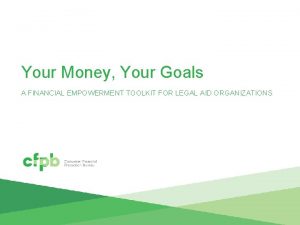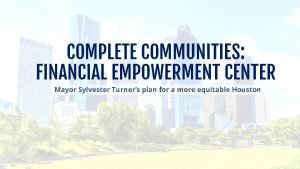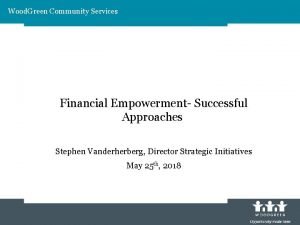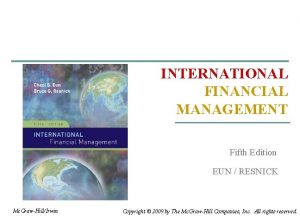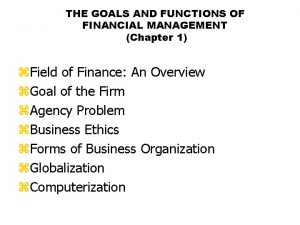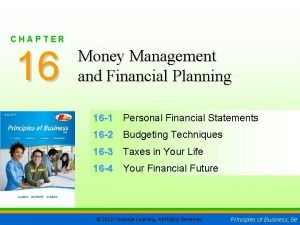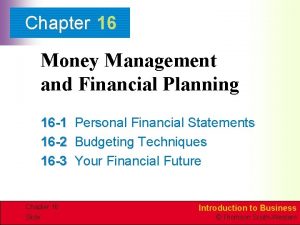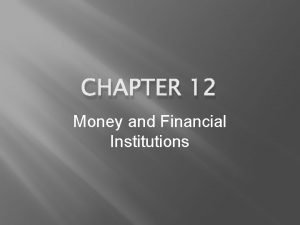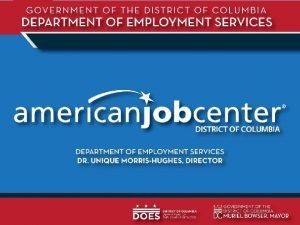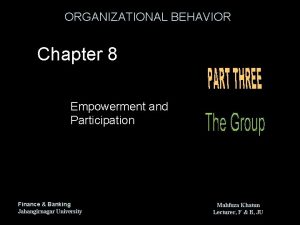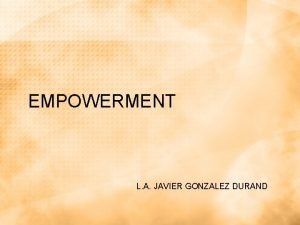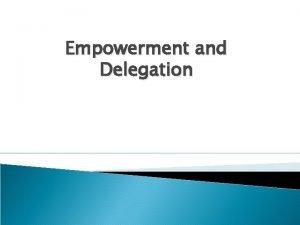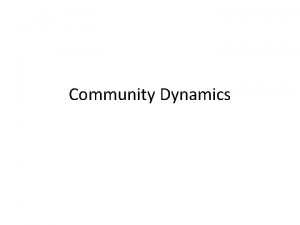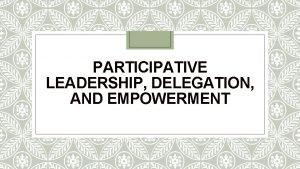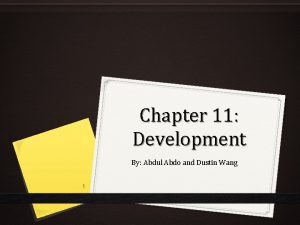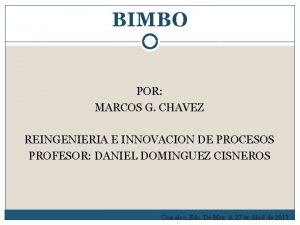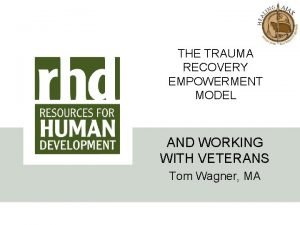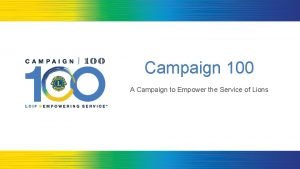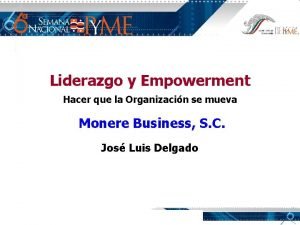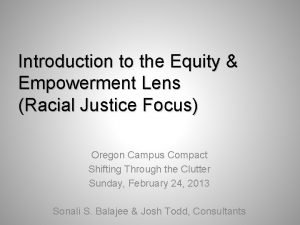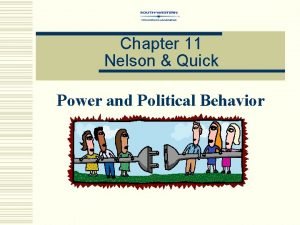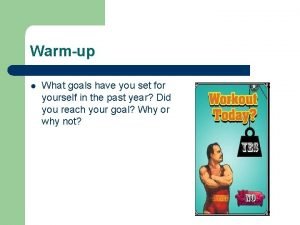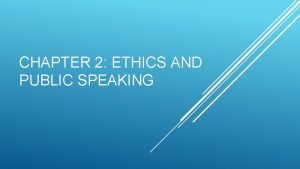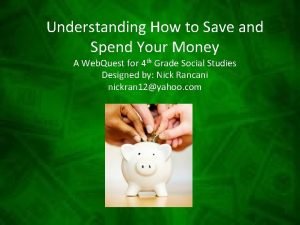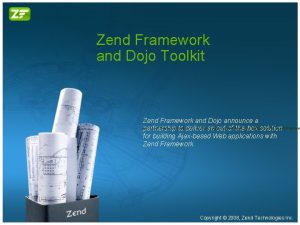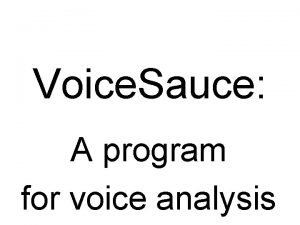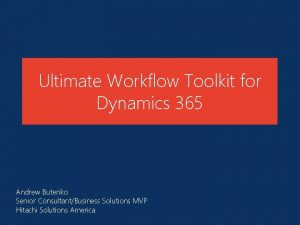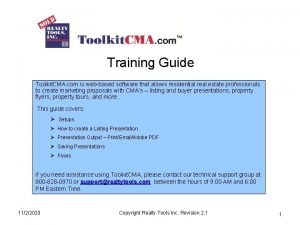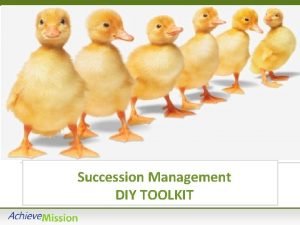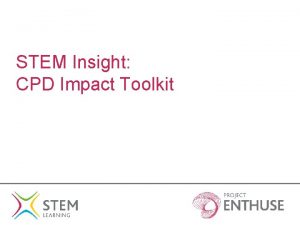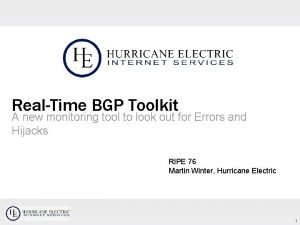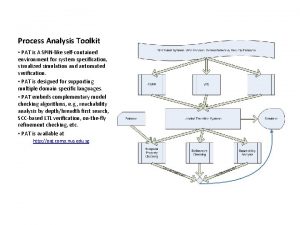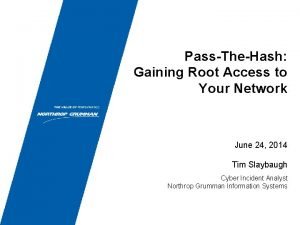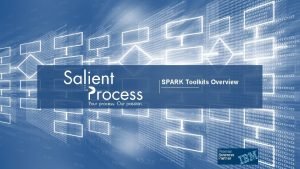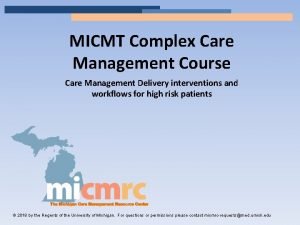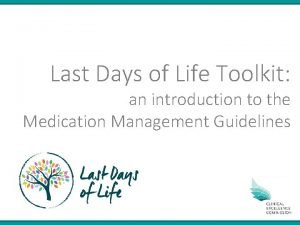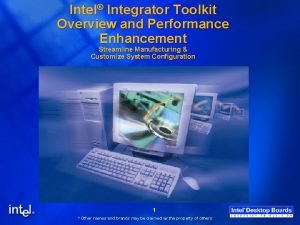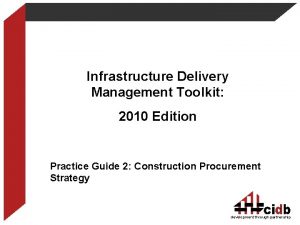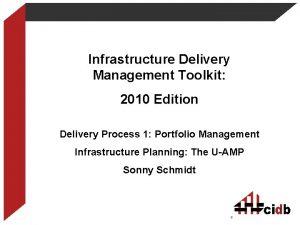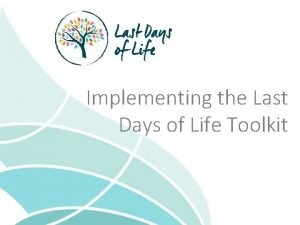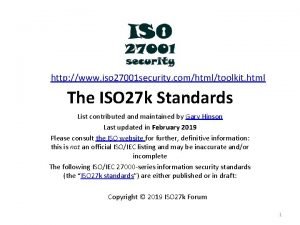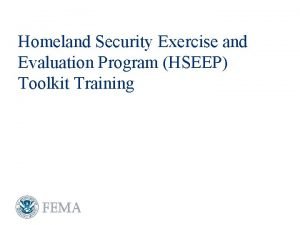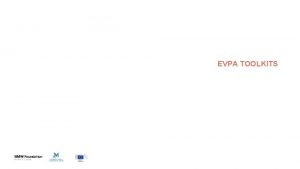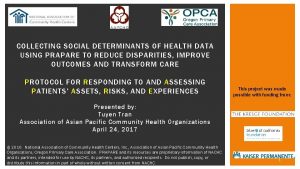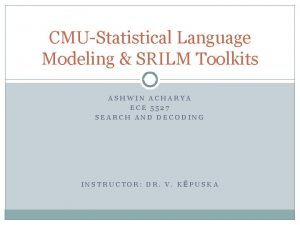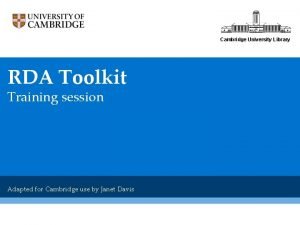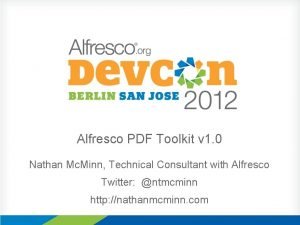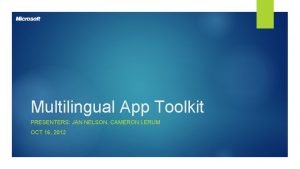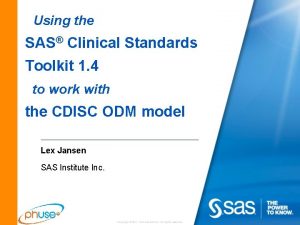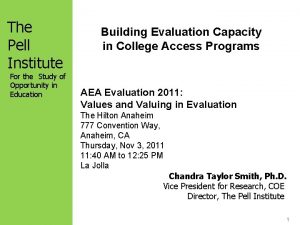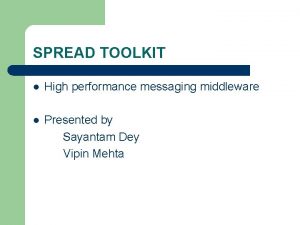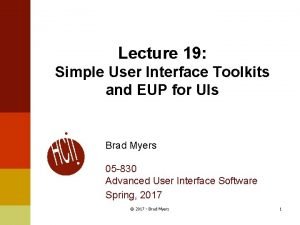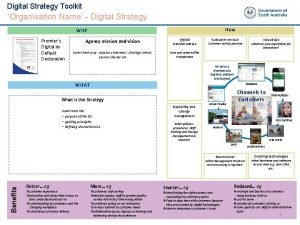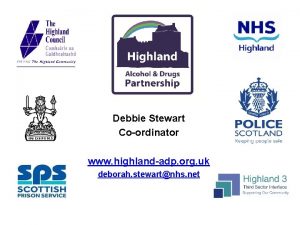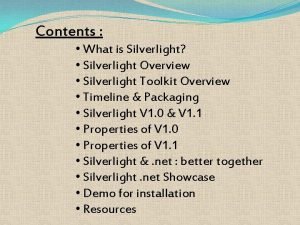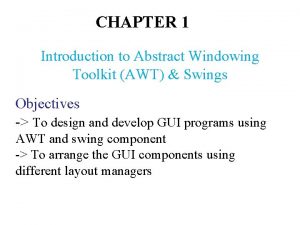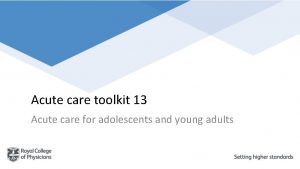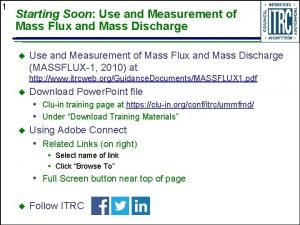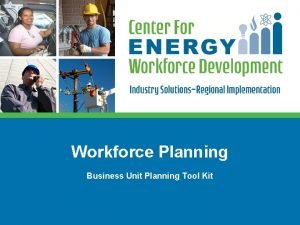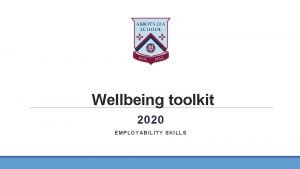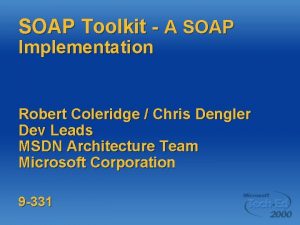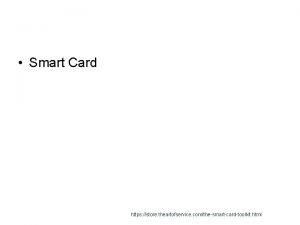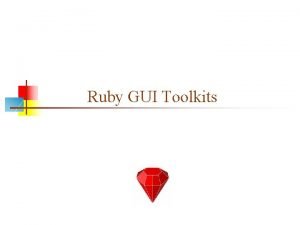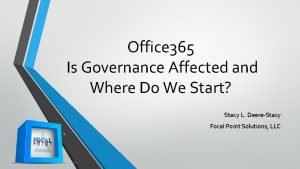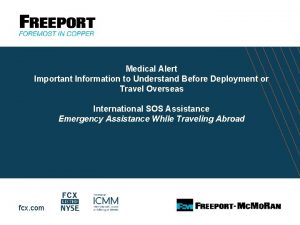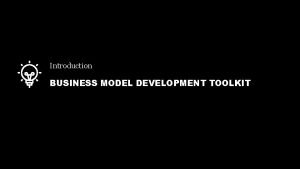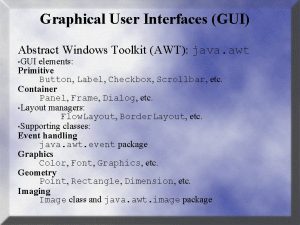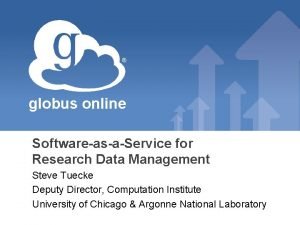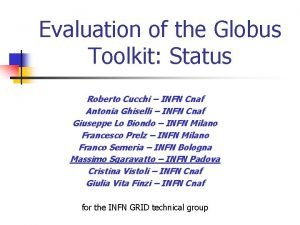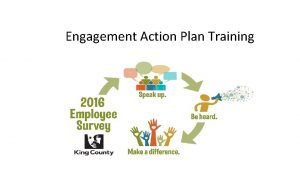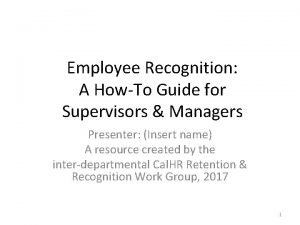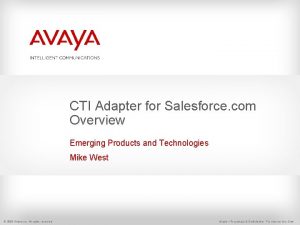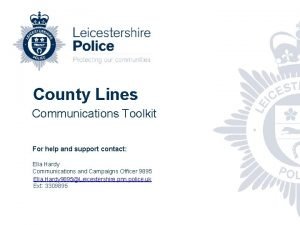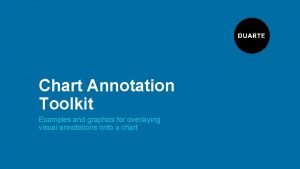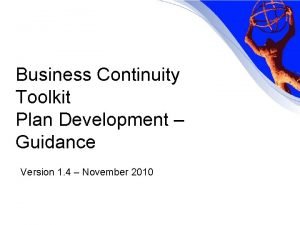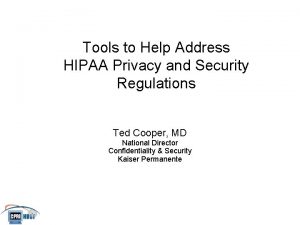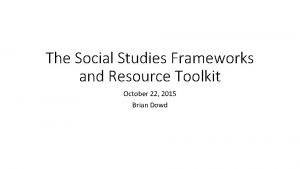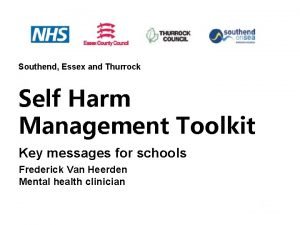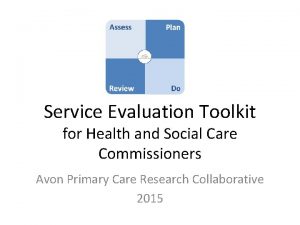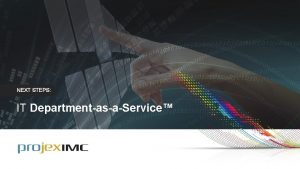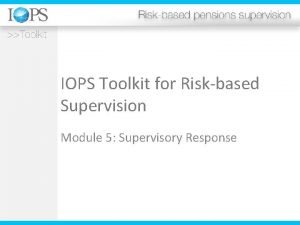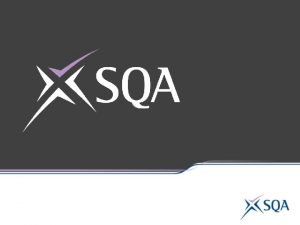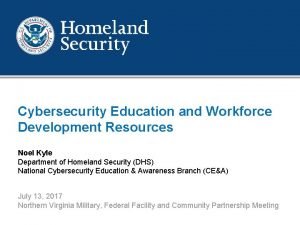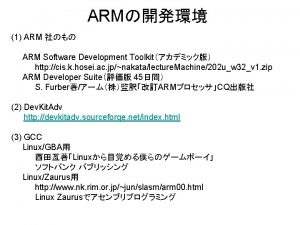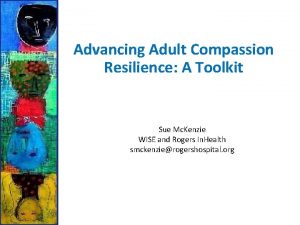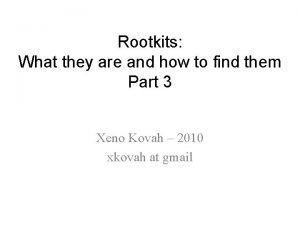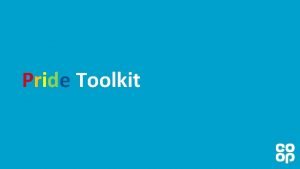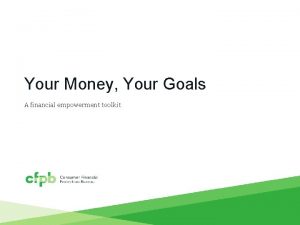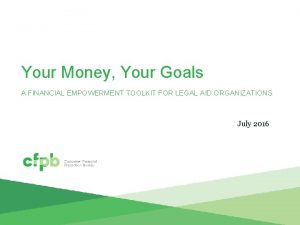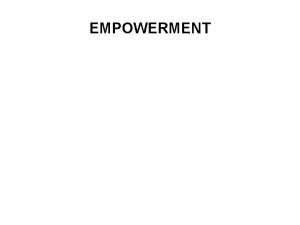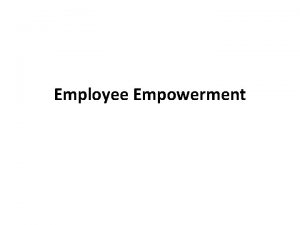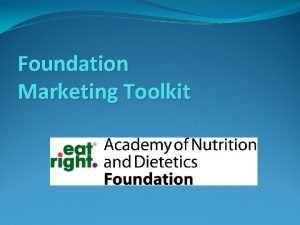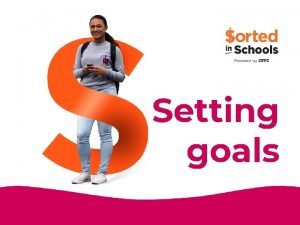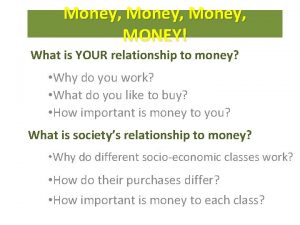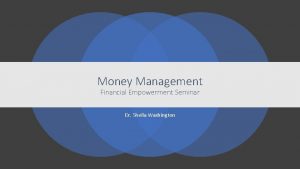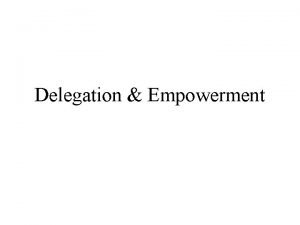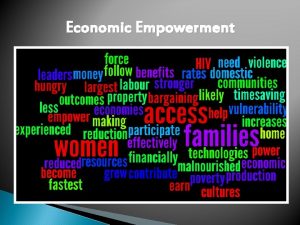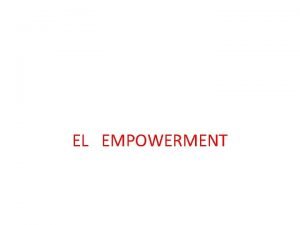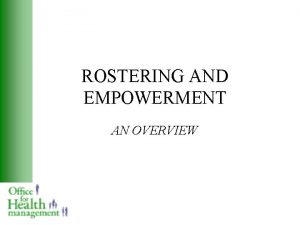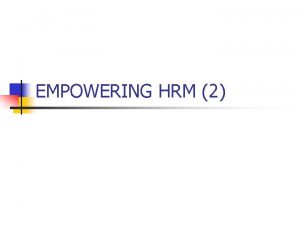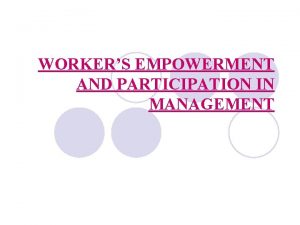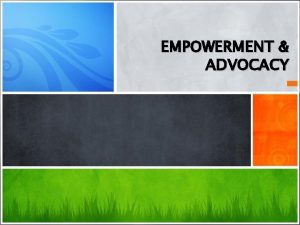Your Money Your Goals A Financial Empowerment Toolkit


























































































































































































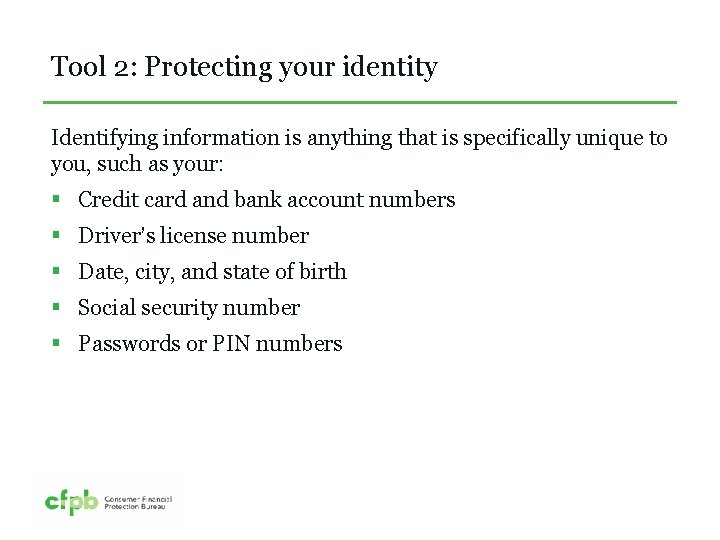
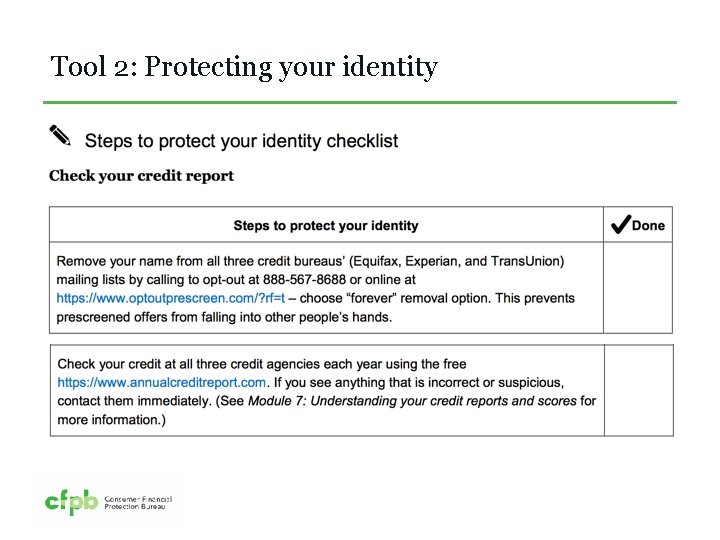
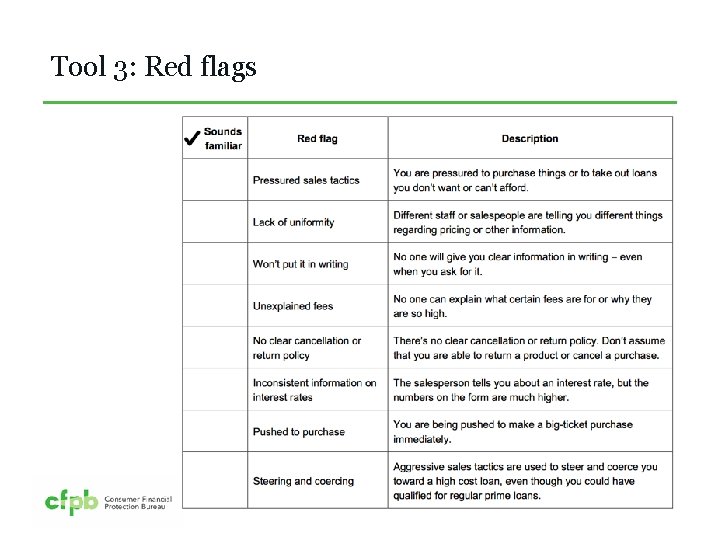
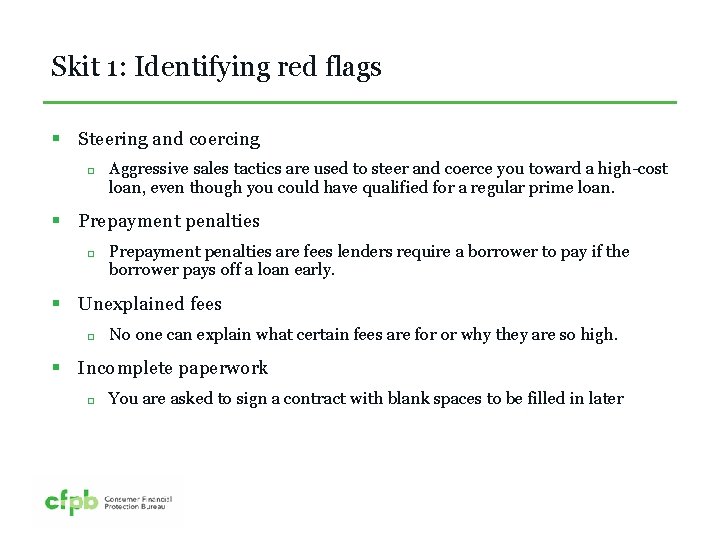

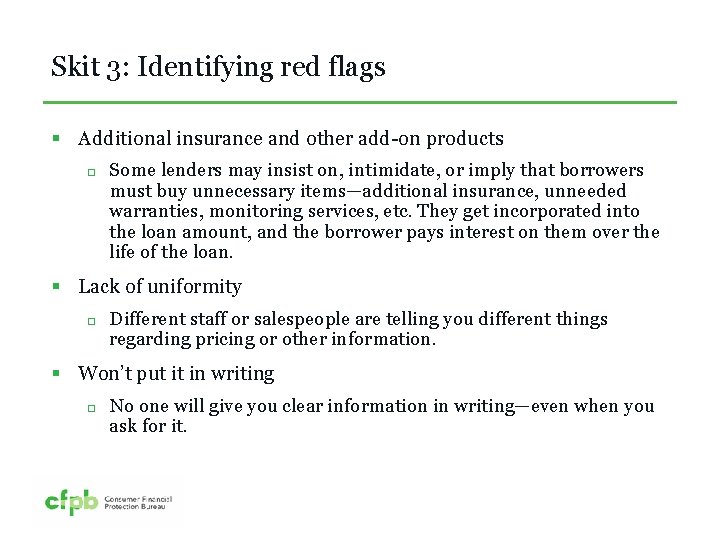
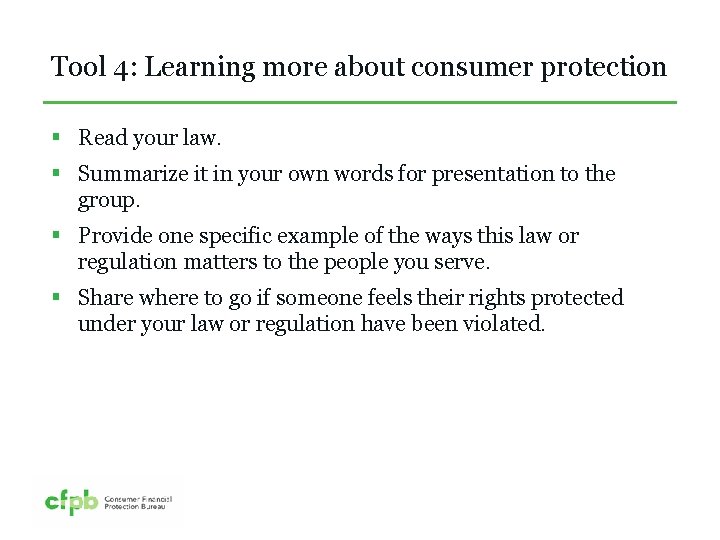
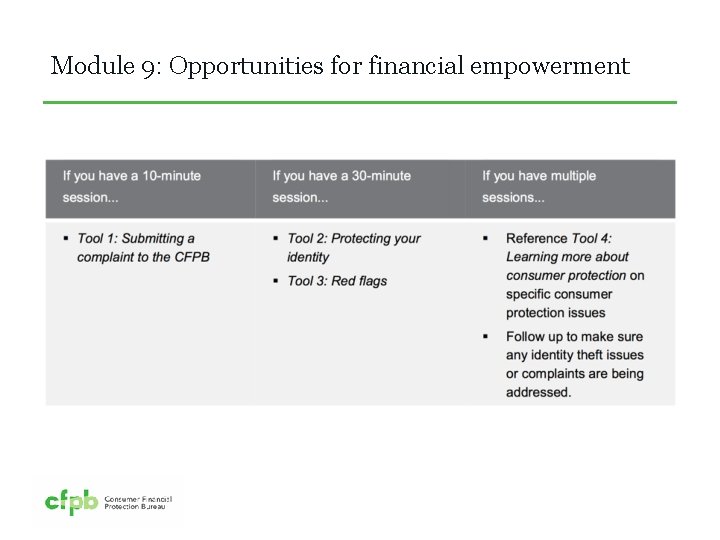

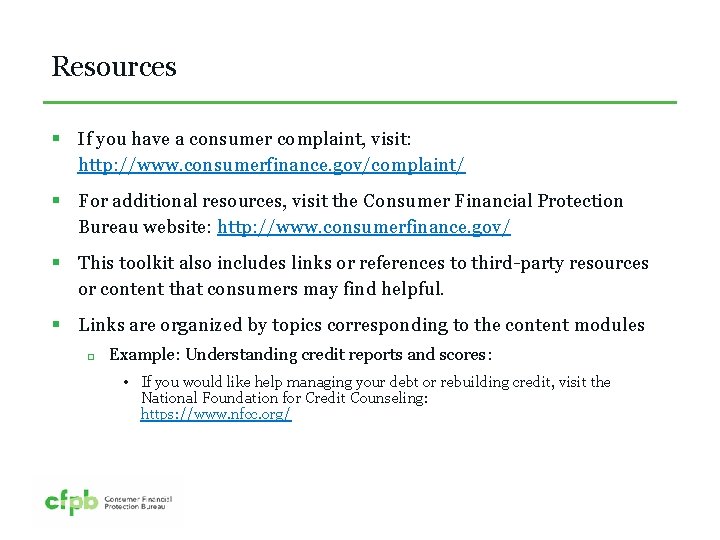

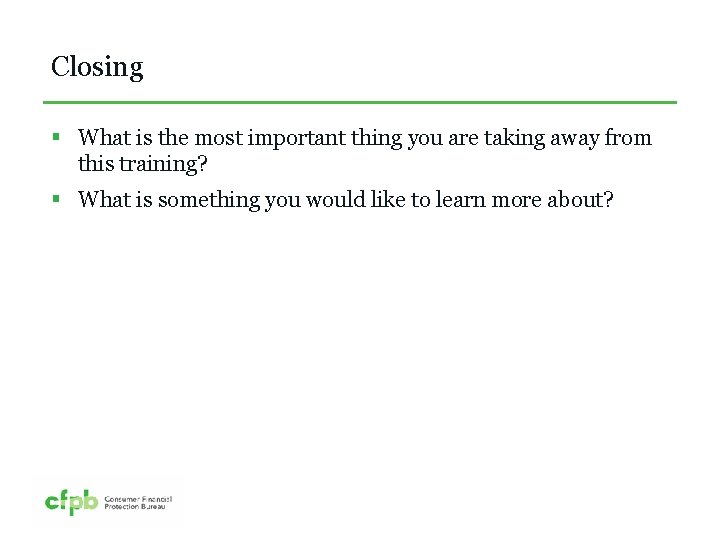
- Slides: 198

Your Money, Your Goals A Financial Empowerment Toolkit February 2017

DISCLAIMER This presentation is being made by a Consumer Financial Protection Bureau representative on behalf of the Bureau. It does not constitute legal interpretation, guidance or advice of the Consumer Financial Protection Bureau. Any opinions or views stated by the presenter are the presenter’s own and may not represent the Bureau’s views. This document includes links or references to third-party resources. The inclusion of links or references to third-party sites does not necessarily reflect the Bureau’s endorsement of the third-party, the views expressed on the third-party site, or products or services offered on the third-party site. The Bureau has not vetted these third-parties, their content, or any products or services they may offer. There may be other possible entities or resources that are not listed that may also serve your needs.

Your Money, Your Goals Opening Activity

Money and me: Opening activity List all of the words, phrases, sayings, songs, or other associations you have with the word money.

Money and me: Opening activity money any generally accepted medium of exchange

Money: What does it mean? § Where do associations about money come from? § How do these associations reflect attitudes and feelings about money? § How are attitudes and feelings related to behaviors and actions? § What does this mean when we are working with the people we serve?

Your Money, Your Goals Overview of the training and introductions

Training purpose § To provide you with: § An orientation to Your Money, Your Goals, a financial empowerment toolkit; § An overview of the training for service providers; § Strategies for using the toolkit, and § The tools, knowledge, and confidence to use the toolkit and provide training on the use of the toolkit to your staff or partners in your community or state.

Training objectives § By the end of the training, you will be able to: § Describe ways to approach integration of Your Money, Your Goals into your work including how to use the toolkit as a complementary resource to other financial capability training and materials. § Describe the purpose of the Consumer Financial Protection Bureau (CFPB) and its rationale for developing Your Money, Your Goals. § Explain the overall organization and content of Your Money, Your Goals. § Explain the tools and resources you have to plan and implement the training for Your Money, Your Goals. § Describe the overall flow of the training, including key activities and methodologies used throughout the Your Money, Your Goals training.

Training objectives By the end of the training, you will be able to: § Increase your knowledge about effective and engaging ways to deliver training. § Explain key financial empowerment concepts presented in Your Money, Your Goals. § Access and use tools and materials available at www. consumerfinance. gov. § Take action to equip frontline staff and volunteers with Your Money, Your Goals through your own trainings and one-on-one instruction, so that they can use the toolkit in their work.

Introduction activity § Share name § Organization § “What do you expect or hope to get from this training? ”

Training presenter The Consumer Financial Protection Bureau created the Your Money, Your Goals toolkit for consumers, as well as the training materials presented today. These materials are being presented to you by a local organization. The organizations or individuals presenting these materials are not agents or employees of the CFPB, and their views do not represent the views of the Bureau. The CFPB is not responsible for the advice or actions of these individuals or entities. The Bureau appreciates the opportunity to work with the organizations that are presenting these materials.

Your Money, Your Goals Introduction to the CFPB and financial empowerment

Introduction to the CFPB § Consumer Financial Protection Bureau § The CFPB’s mission is to make markets for consumer financial products and services work for Americans.

CFPB’s work Empower Enforce Educate

Office of Financial Empowerment § Part of the CFPB’s Division of Consumer Education and Engagement § Serves populations who lack full, affordable access to financial services Low- to moderate-incomes Low wealth Otherwise financially underserved or vulnerable

Your Money, Your Goals

Getting the toolkit

Debt Collection Stories Tell your story. The more we hear from you, the more insight we gain into what’s happening in the financial world and how it’s affecting you. Your experience will help inform how we work to protect consumers to create a fairer marketplace. Both consumers dealing with debt collection, and front-line staff that work with them to help solve issues, are invited to share their stories and add their voice. Tell your story today

Debt Collection Stories After losing her job, Danieshia explains that she was unable to pay her debts and soon found herself being threatened with jail by a debt collector. Watch Danieshia’s Story

Financial empowerment What is financial empowerment? How is it different than financial education, financial literacy, financial capacity, or other commonly used terms? Financial literacy Skill and confidence to use knowledge = Financial empowerment

Financial empowerment and service providers Access Trust = ‘’ Opportunities for providing financial empowerment

Debate Team 1 § As service providers, we should provide financial empowerment information and tools to the people we serve. Team 2 § As service providers, we should not provide financial empowerment information and tools to the people we serve.

Benefit / Cost analysis What are the benefits of financial empowerment What are the costs of financial empowerment § For you? § For the people you serve? § For your program?

Your Money, Your Goals An orientation to the toolkit and the training

Organization of Your Money, Your Goals § Introductory modules Introduction Part 1: Introduction to the toolkit Introduction Part 2: Understanding the situation Introduction Part 3: Starting the money conversation Introduction Part 4: Emotions, values, and culture: What’s behind our money choices?

Organization of Your Money, Your Goals

Organization of Your Money, Your Goals § Content modules Module 1: Setting goals and planning for large purchases Module 2: Saving for the emergencies, bills, and goals Module 3: Tracking and managing income and benefits Module 4: Paying bills and other expenses Module 5: Getting through the month Module 6: Dealing with debt Module 7: Understanding credit reports and scores Module 8: Money services, cards, accounts, and loans: Finding what works for you Module 9: Protecting your money § Resources

Organization of Your Money, Your Goals

Organization of Your Money, Your Goals

Where would you start if someone. . . 1. Felt overwhelmed by debt? 2. Felt like she couldn’t make ends meet? 3. Wants to buy a car and get the best rate she can for the money she must borrow? 4. Wants to understand direct deposit and payroll cards? 5. Has used high-cost credit products in the past and wants to avoid these in the future? 6. Wants to make changes but does not have clear goals? 7. Has no savings but wants to start? 8. Wants to open an account but doesn’t know what kind of account or where?

What would you do if someone. . . 1. Wants to file for bankruptcy? 2. Wants to know how to respond to a creditor’s threat to sue? 3. Is facing eviction? 4. Is facing foreclosure? 5. Is not able to provide enough food for herself and other members of her household? 6. Is in danger of losing her car due to nonpayment? 7. Wants to take out a debt consolidation loan? 8. Wants to know how to finance her child’s college?

Creating a Referral Guide

Financial empowerment checklist § The goal is not to cover all of the tools with each person. § Instead, find the right module or tools based on: Their most pressing financial empowerment problem The area in which they’ve expressed an interest in getting more help

Intro Part 1, Tool 1: Financial empowerment checklist Print off and keep with an individual’s file if appropriate Use to connect meetings you’ve had

Train-the-trainer model During the training of trainers today, you will learn: 1. Organization and content of the toolkit 2. How the training is organized 3. Tools that can help you plan & deliver the training Starting today, you develop a plan to train other staff or community members to use the toolkit in their day-to -day work—the organization and content of the toolkit as well as how to use the toolkit with people. Then you will: You deliver trainings on Your Money, Your Goals to frontline staff in your organization and community. You administer and submit pre- and posttraining surveys as well as trainer surveys

Tools for implementation

Instructions for facilitator or trainer § Facilitation instructions can be found in the “notes” section of the training Power. Point presentation. § This training may be used without modification, but trainers may feel welcome to add activities that they feel are more relevant for the attendees.

Instructions for facilitator or trainer: Go to view and select “notes page

Instructions for facilitator or trainer Module 4: Paying Bills and Other Expenses Estimated Time: 30 Minutes Methodology: Vote with Your Body / Presentation / Tool Analysis / Small Group Exercise Corresponding Section in toolkit: Module 4 (Pages 137)

Instructions for facilitator or trainer Instructions for Facilitator: Vote with Your Body § Prior to the session, hang up three signs on the walls: “Need, ” “Want, ” and “Obligation. ” § Review the definition of spending. § Review the definitions of needs, wants, and obligations. § Tell people you are going to read off a list of items that you could spend money on. Use the list of example expenses below or use others that may be more contextually or culturally relevant to the people you are training. Limit the number of examples to 4 – 6. § Ask participants to stand under the sign that best represents the category they would put that item in: need, want, or obligation.

Effective training § To be effective, the training needs to be engaging. § Every section of the training has at least one activity built into it. § Minimally, follow the instructions in the training, and you will create an interactive experience. § Lecture alone or lecture and discussion is not engaging and not effective.

Methodologies used in training § Opener—contest § Exercise in pairs § Icebreaker § Carousel § Presentation § Contest § Facilitated discussion § Scavenger hunt § Brainstorming § Role play § Individual activity § Skit § Large group activity § Tool analysis § Small group exercise § Vote with your body

Interactive exercises § Opening activity—Money and me Small group brainstorming set up as a contest and large group facilitated discussion § Financial empowerment and service providers Debate OR cost benefit analysis § Orientation to the toolkit Scavenger hunt in small groups § Creating a referral guide Build a chart

Interactive exercises § Understanding the situation and starting the money conversation Individual exercise (financial empowerment self-assessment) Small group brainstorm Top 10 Money Conversations—instead of scavenger hunt § Setting goals and planning for large purchases (Module 1) Scenarios in small groups

Interactive exercises § Saving for emergencies, bills, and goals (Module 2) Small group brainstorm and analysis Discussion in pairs using example (spark plug example) Completing the asset limits chart § Tracking and managing income and benefits (Module 3) Individual tool review § Paying bills and other expenses (Module 4) Vote with your body (needs, wants, obligations) Individual tool review (bill calendar) Small group exercise (strategies for cutting expenses) Small group exercise (consequences of skipping bills)

Interactive exercises § Getting through the month (Module 5) Scenario analysis (Raphael) Small group brainstorm (improving cash flow checklist) § Dealing with debt (Module 6) Stand up, sit down (good debt, bad debt) Exercise in pairs (Shawna DTI)

Interactive exercises § Understanding credit reports and scores (Module 7) Credit report scavenger hunt Large group exercise (keeping records) § Money services, cards, accounts, and loans (Module 8) Individual exercise (know your options) Exercise in pairs / large group discussion (money services) § Protecting your money (Module 9) Skits (red flags) Teach back (learning about consumer protection)

Keys to interactive training § Read the facilitator’s guide and be sure you understand how to facilitate the activity. This generally takes more than one reading. § Make notes to personalize the activity. § Prepare, prepare. § Understand that it may take you longer to facilitate an activity that you are unfamiliar with. § Better to cover less content using interactive approaches than all of the content using presentation or lecture only.

Your Money, Your Goals Understanding the situation and starting the money conversation

Financial empowerment self-assessment Complete Tool 2: Financial empowerment self-assessment Reflection Questions § How did you feel about completing this assessment? § Were there topics you knew more about than you thought you would? § What topics would you like to learn more about? § How can you learn more about them?

Situation assessment A picture of conditions today used to inform and plan for actions to change conditions in the future

Introduction Part 2, Tool 1: My money picture

Introduction Part 2, Tool 1: My money picture

Make the most of short-term contacts Broaden the conversation Respond when people initiate directly or indirectly

Other strategies for starting the conversation Brainstorm with your group specific opportunities for beginning the financial empowerment conversation.

Your Money, Your Goals Module 1: Setting goals and planning for large purchases

SMART goals § Specific § Measurable § Able to be reached § Relevant § Time-framed

Hopes, wants, and dreams vs. strong goal Hopes, wants, and dreams Strong goal I’d like to buy a new television. I will save $400 and purchase a new television in six months. I want to get out of credit card debt. I will pay down $1, 000 of my debt over the next 18 months.

Goal-setting tool Brainstorm list of hopes, wants, and dreams SMART goals Action plan Figure out weekly savings target Becomes part of cash flow budget May become the purpose for the cash flow budget

Action plan Goal: ________________

Calculating weekly savings target Total amount needed Number of weeks to reach goal Amount to set aside each week

Calculating weekly savings target Total amount needed $300 For end of the year holidays Number of weeks to reach goal Amount to set aside each week 12 weeks $25 per week

Life cycle events and large purchases What is a life cycle event likely to cost? Everyone is different, but here are some estimates we have seen: § Out of pocket childbirth expenses for women with insurance coverage—$3, 400 § Out of pocket expenses associated with breast cancer— $712/month § Quinceañera—coming of age celebration for 15 -year old girls in Latino families—$15, 000 to $20, 000 § Typical cost for final expenses—$10, 000

Planning for life events and large purchases § Group 1: 18 -year old graduating from high school. Plans to attend trade school to become a skilled welder. § Group 2: 28 -year old food services manager at a state university diagnosed with cancer. He is married and has an infant. § Group 3: 36 -year old mother who is getting divorced. She has two children ages 4 and 8. Must find a job for the first time in 9 years; before having children she was a math teacher in the public school system. § Group 4: 45 -year old man being downsized out of manufacturing job. Married with one child who is 15 years old. The child has plans to go to college out of state. § Group 5: 56 -year old long-haul truck driver who would like to retire in 6 years. Has saved minimally for retirement. Children are grown and out of the house; however, one has lost his job and has plans to return home with his two preschool children.

Planning for life events and large purchases § What are the reasons for thinking about and anticipating life events and large purchases? § Do most people do this? Why or why not? § How does an exercise like this empower individuals? § How can an exercise like this backfire? § What did you learn from this exercise?

Tool 2: Planning for life events and large purchases

Tool 3: Buying a car 1. Be prepared before you shop for an auto loan 2. Know what you can negotiate 3. Avoid long-term loans if you can 4. Review your loan contract before signing

Module 1: Opportunities for Financial Empowerment

Your Money, Your Goals Module 2: Saving for emergencies, bills, and goals

Saving § What is savings? § Savings is money you set aside today from your income for use in the future § What are examples of unexpected expenses or emergencies?

Cost of unexpected auto repair = $350

Tool 1: Savings plan

Tool 2: Savings and benefits What are the reasons this tool is included?

Tool 3: Finding a safe place for savings § Where can you keep money you save? § What are the benefits? A benefit is something that provides you with an advantage. A benefit is something that is good for you. § What are the risks? A risk is any chance for loss. Where there is risk, there is uncertainty in the outcome or result.

Tool 3: Finding a safe place for savings

Banking history reports § Information about prior accounts, such as routing transit number and account number § The date information was reported about an account § The reason for the report, such as an unpaid overdraft balance § Whether your prior banking institution suspected you of committing fraud § Information on returned checks from retailers and other businesses

Tool 4: Increasing your income through tax credits For the 2017 tax season, these income limits apply for the EITC. All information regarding tax credits from the Internal Revenue Service at www. irs. gov.

Tool 4: Increasing your income through tax credits Note: Starting in 2017, the IRS will be required to do additional verification of information on tax returns claiming the EITC and the CTC. This may cause some delay in the receipt of refunds which include these tax credits. For more information go to https: //www. irs. gov/for-taxpros/new-federal-tax-law-may-affect-some-refunds-filed-inearly-2017.

Module 2: Opportunities for financial empowerment

Your Money, Your Goals Module 3: Tracking and managing income and benefits

Income, benefits, and wage garnishments Income § Regular income § Irregular income § Seasonal § One-time occurrence Benefits Wage garnishments

Tool 1: Income and resource tracker

Tool 2: Ways to receive income and benefits § Cash § Paychecks § Direct deposit § Payroll cards § EBT

Tool 2: Ways to receive income and benefits

Tool 3: Ways to increase income and resources § Review this tool on Pages 133 – 136 § Think about the people that you serve. § Which strategies listed do you think are most feasible for them? Circle these. § What strategies are missing? Add these.

Tool 3: Ways to increase income and resources

Module 3: Opportunities for financial empowerment

Your Money, Your Goals Module 4: Paying bills and other expenses

Paying bills and other expenses Spending § Money you use to pay for a wide range of basic needs, your financial obligations, and other things you may want. Needs, wants, and obligations § Needs are things you must have to live. § Wants are things you can survive without. § Obligations are things you must pay because you owe someone money (a car loan) or have been ordered to pay someone (child support).

Tool 1: Spending tracker

Analyze spending • Spending that cannot be cut • Spending that can be eliminated • Spending that can be reduced

Tool 2: Bill Calendar

Tool 3: Ways to pay bills

Tool 4: Strategies for cutting expenses § Review this tool on Pages 155 - 159. § Think about the people you serve. § Which strategies listed do you think are most feasible for them? Circle these. § What strategies are missing? Add these.

Tool 4: Strategies for cutting expenses

Consequences of skipping bills Group 1: a. Consequences of paying rent late. b. Consequences of missing multiple rent payments. Group 2: a. Consequences of making car payment late. b. Consequences of missing multiple car payments. Group 3: a. Consequences of being late with electricity bill. b. Consequences of multiple late electricity bill payments. Group 4: a. Consequences of missing payday loan payment. b. Consequences of missing credit card payment.

Tool 5: Prioritizing bills

Module 4: Opportunities for financial empowerment

Your Money, Your Goals Module 5: Getting through the month

Getting through the month § What is a cash flow budget? § How is it different from a regular budget? § What do you think may be the benefit of this approach?

Cash flow budget Week 1 Beginning balance for the week Week 2 $37. 00 $122. 37 Income from job $305. 34 $290. 80 SNAP $280. 00 Public housing voucher $650. 00 Sources of cash and other financial resources Total sources of cash and other financial resources $1, 272. 34 $413. 17 Uses of cash and other financial resources Savings $20. 00 Housing $650. 00 Utilities $59. 97 $95. 50 $180. 00 $240. 00 $60. 00 $1, 149. 97 $255. 50 $122. 37 $157. 67 Groceries Eating out (meals and beverages) Transportation Total uses of cash and other financial resources Ending balance for the week Ending balance from previous week To get a starting balance, total your cash, debit card , and account balances.

Cash flow budget Week 1 Beginning balance for the week Week 2 $37. 00 $122. 37 Income from job $305. 34 $290. 80 SNAP $280. 00 Public housing voucher $650. 00 Sources of cash and other financial resources Total sources of cash and other financial resources $1, 272. 34 $413. 17 Uses of cash and other financial resources Savings $20. 00 Housing $650. 00 Utilities $59. 97 $95. 50 $180. 00 $240. 00 $60. 00 $1, 149. 97 $255. 50 $122. 37 $157. 67 Groceries $20. 00 Eating out (meals and beverages) Transportation Total uses of cash and other financial resources Ending balance for the week Total sources minus total uses This becomes your beginning balance for next week.

Reading a cash flow budget: Scenario overview § Rafael is a single parent with two children. § He is often late with his rent and other bills, because he does not have the money when he needs it. § After tracking his spending, he developed a cash flow budget with an educator at a parenting class he takes through Cooperative Extension in his community. § Using the cash flow, make some recommendations to Rafael so he can make ends meet.

Managing cash flow scenario

Cash flow analysis questions 1. When does Rafael run out of money? 2. What can he do (or try to do) to better match the timing of his income and his expenses? Develop a prioritized list. 3. How does the SNAP benefit factor into the cash flow? 4. The next month is not included in the example. What will Rafael’s situation be at the beginning of next month? How much cash will he have? What bills will he have? What should he do now to prepare for the following month?

Developing a cash flow budget 1. Use information from: Tool 1: Income and resource tracker from Module 3: Managing income and benefits Tool 1: Spending tracker from Module 4: Paying bills and other expenses. Spending analysis section of Tool 1: Spending tracker from Module 4: Paying bills and other expenses. to understand your current situation.

Developing a cash flow budget 2. Review your goals. 3. Review Planning for life events and large purchases worksheet if completed. 4. Choose format for cash flow. Tool 1: Cash flow budget or Tool 2: Cash flow calendar. 5. Write the following in the approximate week you expect each item to happen: Projected income, benefits, and others resources, and Spending that cannot be cut.

Developing a cash flow budget 6. Set targets for spending to help create savings for goals, life events, and large purchases. Spending that can be eliminated Spending that can be reduced 7. Fill in savings for goals, life expenses, and large purchases.

Tool 1: Cash flow budget

Tool 2: Cash flow calendar

Tool 3: Improving cash flow checklist Increase sources of cash, income, or other financial resources, including accessing public benefits and applying for tax credits for which you qualify. Decrease your spending or uses of cash and other financial resources. Match timing of sources and uses of income where possible.

Tool 3: Improving cash flow checklist

Module 5: Opportunities for financial empowerment

Your Money, Your Goals Module 6: Dealing with debt

What is debt? § What is debt? Money you owe. Debt is a liability. Debt may obligate future income. § How is debt different from credit? For our purposes… Credit is the ability to borrow money. Debt is the result of using credit.

Good debt, bad debt § Loan from friend or family member § Car loan § Student loan § Payday loan § Mortgage (loan for a home) § Car title loan § Pawn shop loan

Rent-to-own arrangements § Leasing consumer goods, typically with the option to purchase the item by continuing to make payments for some specified period of time § Typically more expensive than if purchased outright § Items can be confiscated if payments are not made as agreed § You have the option to return the item at any time

Co-signers: Agree to repay the loan Co-signing on a loan § Means you have the same obligation to pay the debt as the borrower § Can result in you having to repay any missed payments § Can affect your credit score and ability to obtain a future loan Before co-signing, read the terms of the loan and consider carefully before taking on the risk.

Medical debt What are the factors that can lead to medical debt? § Medical debt is almost always the result of an unplanned event—someone becoming ill or injured. § The costs of the care almost never fully known upfront. § Invoices and bills may be confusing § Uninsured individuals are generally charged more for services

Avoiding medical debt § Get cost estimates up front § Find out whethere is a prompt payment discount § Ask for a discount on the treatment § Ask about “charity care” § If you are asked to put a hospital bill on a credit card, be careful § Work with the health care provider to set up a reasonable repayment plan

Payday loans Borrower gets loan. Borrower visits payday lender. No credit check or consideration of borrower’s ability to repay the loan Median loan is $350 and fees range $10 - $30 for each $100 borrowed Borrower gives lender 14 -day postdated check. The amount borrowed + fees $350 + 52. 50 = 402. 50 In 14 days, if the borrower doesn’t have the money, loan is renewed. Borrower must pay $52. 50 to renew. Every 14 days, the borrower must pay the loan or renew it. The average borrower has 10 transactions per year. In this example, it would cost $525 to borrow $350.

Debt settlement services § What is debt settlement? § Should you use a debt settlement service to deal with your debt? § What are the consequences of using a debt settlement service? § What are some red flags to watch out for when deciding to do business with a debt settlement service?

Tool 1: Debt worksheet On the debt management worksheet, you will include: § The person, business, or organization you owe money to; § The amount you owe them; § The amount of your monthly payment; and § The interest rate you are paying and other important terms. To complete this worksheet, you may need to get all of your bills together in one place and a copy of your credit report.

Tool 2: Debt-to-income worksheet How much debt is too much? § Debt-to-income ratio § This simple calculation shows you how much of your income goes toward paying your debt. § The debt-to-income ratio is good measure of how much of your income is obligated to debt.

Tool 2: Debt-to-income worksheet

Tool 2: Debt-to-income worksheet Renters § Consider maintaining a debt-to-income ratio of. 15 -. 20, or 15% 20%, or less. Homeowners § Consider maintaining a debt-to-income ratio of. 28, or 28%, or less for just the mortgage (home loan), taxes, and insurance. § Consider maintaining a debt-to-income ratio for all debts of. 36, or 36%, or less.

Debt-to-income $. 50 is going to debt $. 50 for everything else: • Car repairs • Taxes • Home repairs • Utilities • Appliances • Cell phone • Furniture • Gasoline • Household • Food supplies • Clothing • Pet food and • School fees supplies • Gifts • And so on • Savings

Debt-to-income calculation activity Shawna has just graduated, completing her associates degree in nursing. She has already landed a full-time job earning $17. 50 per hour. She works full time (160 hours per month). She will be working at a hospital 21 miles from her home and public transportation is not a viable option for her. She found a good used car, but she can’t afford to buy it without a loan. Her monthly payments on that loan would be $158. Every month she also pays the following debts: § School loan $205. 00 § Credit card #1 $90. 00; Credit card #2 $55 § Mortgage $625. 00 What is the debt to income ratio without car loan? With the car loan? Based on her DTI, do you think she can afford the loan?

Tool 3: Reducing debt worksheet § The two primary methods for reducing debt are: Highest interest rate method Snowball method § Consider the pros and cons of each.

Tool 4: Repaying student loans § Federal student loans versus private student loans § Options for federal student loan repayment include: Standard payment Income-Based Repayment (IBR) Pay As You Earn (PAYE) Revised Pay As You Earn (REPAYE) Graduated payment Extended payment

Student loan debt Visit http: //www. consumerfinance. gov/paying-for-college

Tool 5: When debt collectors call § If you have questions about the debt, do not send money or even acknowledge the debt the first time you are contacted. Why? You want to make sure you actually owe the debt, and You want to make sure the individual contacting you really has the authority to collect the debt § Also, ask for the name, number and address for the debt collector and request information about the debt in writing.

Verify the debt

Verify the debt

Verify the debt

Know your rights The Fair Debt Collection Practices Act protects consumers from harassment: § Repeated phone calls intended to annoy, abuse, or harass § Obscene or profane language § Threats of violence or harm § Publishing lists of people who refuse to pay their debts § Calling you without telling you who they are § Using false, deceptive, or misleading practices

Module 6: Opportunities for financial empowerment

Your Money, Your Goals Module 7: Understanding credit reports and scores

Why do credit reports and scores matter? § Get and keep a job § Get and keep a security clearance for a job, including a military position § Get an apartment § Get insurance coverage § Get lower deposits on utilities and better terms on cell phone plans § Get a credit card § Get better loan terms

Understanding credit reports & scores § Header/identifying information § Public record information § Collection agency account information § Credit account information § Inquiries made to your account

Negative information § Negative information can be reported to those who request your credit report for only a specified period of time —seven years for most items. § Bankruptcy can stay on your credit report for 10 years. § Civil suits and judgments can be reported on your credit report for seven years or until the statute of limitations has expired, whichever is longer. § There is no time limit to the length of time that positive information can stay on your credit report.

Negative information § Consumer reporting companies cannot include information that is beyond the limits provided in the Fair Credit Reporting Act (FCRA) in most consumer credit reports, but they may continue to keep the information in your file. That’s because there is no time limit in terms of reporting information (positive or negative) when you are: Applying for credit of $150, 000 or more Applying for life insurance with a face value of $150, 000 or more Applying for a job with an annual salary of $75, 000 or more

Reading a credit report 1. Who does this credit report belong to? 2. Where does this person live? 3. Where does he work? How long has he worked there? 4. Does he have public records? If yes, describe it (them). 5. Is he late on any of his accounts? If yes, describe. 6. Are any of his accounts in good standing? If yes, describe. 6. What are the balances of his accounts in the account information section? 7. Does he have accounts in collection? What is the balance owed in collections? 8. What do his inquiries tell you? 9. What is your opinion of this person’s credit history. Is it positive or negative?

National credit-reporting agencies § Equifax § Experian § Trans. Union www. annualcreditreport. com

Getting free, annual credit reports

Getting free, annual credit reports

Getting free, annual credit reports § Online: Get a free copy of your credit report at Annual. Credit. Report. com § By mail: Download and complete the Annual Credit Report Request Form and mail it to: Annual Credit Report Request Service P. O. Box 105281 Atlanta, GA 30348 -5281

Getting free, annual credit reports https: //www. annualcr editreport. com/manua l. Request. Form. action

Credit scores: Example based on FICO score These percentages reflect how much each category determines a typical FICO score.

Credit utilization rate example § $5, 000 credit limit § $3, 500 charged § $3, 500 (amount charged) ÷ $5, 000 (credit limit) = 0. 7 or 70%

Factors that influence credit scores: Vantage. Score example

Tool 1: Getting your credit reports and scores § To order through the website, visit: https: //www. annualcreditreport. com § Select the report(s) you want—Equifax, Experian, and/or Trans. Union. Answer security questions: former addresses, amount of a loan you have, phone numbers that have belonged to you, counties you may have lived in, etc. If you are unable to answer these questions, you will have to use another method. § Complete a form with basic information (name, Social Security number, address, etc. ). You will save a PDF version of your report, print the report, or both. Be sure you do this in a safe and secure location. Avoid doing this on public computers (library).

Tool 2: Credit report review checklist

Filing a dispute § To correct mistakes, it can help to contact both the credit reporting company and the source of the mistake. § You may file your dispute online at each credit reporting agency’s website. § If you file a dispute by mail, your dispute letter should include: Your complete name, address, and telephone number; your report confirmation number (if you have one); and the account number for any account you may be disputing. § In your letter, clearly identify each mistake, state the facts, explain why you are disputing the information, and request that it be removed or corrected. § You may want to enclose a copy of the portion of your report that contains the disputed items and circle or highlight the disputed items. § Send your letter of dispute to credit reporting companies by certified mail, return receipt requested.

Tool 3: Improving credit reports and scores

Tool 4: Keeping records to show you’ve paid bills When repairing or building credit – or managing finances more generally – it is important to create a paper trail. What does this mean? It means you must keep records so you can prove that you have: Paid a bill on time that a creditor has reported late. Paid a debt that a creditor has reported unpaid. Sent a letter to a debt collector who has claimed he did not receive it. Insurance coverage. A warranty for a cell phone. Paid your rent in cash (you have a receipt).

Tool 4: Keeping records to show you’ve paid bills

Ordering, reviewing, and improving § Ordering = Use Tool 1 § Reviewing = Use Tool 2 Credit report review checklist • Ensure ALL information is correct—personal information, public record information, account/trade information, collection account information. • Make sure negative information is not being reported longer than it should be. § Improving = Use Tool 3 • Improving credit reports and scores § Proving = Use Tool 4 • Keeping records to show you have paid bills

Module 7: Opportunities for financial empowerment

Your Money, Your Goals Module 8: Money services, cards, accounts, and loans: Finding what works for you

Financial service providers § Department stores—credit cards or charge cards § Automobile dealers—car loans § Retail superstores, convenience stores, grocery stores, and other stores—check cashing, bill payment, money orders, prepaid cards, and money transfers § Check cashers and payday lenders – check cashing, money transfers, bill payment, money orders, prepaid cards, and short-term loans § Online companies—money transfers, bill payment services, loans, financial management tools, online “wallets” or “accounts” § Mortgage companies—loans for homes § Commercial tax preparers—refund anticipation loans § Consumer finance companies—loans § U. S. Postal Service—money orders and money transfers

Tool 1: Know your options: Money services, cards, accounts, and loans § Complete Tool 1 on Page 281. § Do not look ahead in your materials.

Tool 1: Know your options: Money services, cards, accounts, and loans

Tool 2: Ask questions: Choosing where to get what you need § What surprised you when using this tool? § Was the tool helpful? Do you think it will be helpful for your work? § What additional information do you need to select a financial service provider?

Tool 2: Ask questions: Choosing where to get what you need

Tool 3: Money services and banking basics § With your partner: Define the product or service. Brainstorm all of the places you can get this product or service. Brainstorm when you would use this product or service to manage your finances. List the benefits of this product or service. List the risks of this product or service. § Be prepared to present your product or service and your work to the rest of the group.

Checking account Definition Where can you get this product/service When would you use this product/service Benefits Risks

Prepaid debit card Definition Where can you get this product/service When would you use this product/service Benefits Risks

Money transfer Definition Where can you get this product/service When would you use this product/service Benefits Risks

Bill payment service Definition Where can you get this product/service When would you use this product/service Benefits Risks

Savings account Definition Where can you get this product/service When would you use this product/service Benefits Risks

Line of credit Definition Where can you get this product/service When would you use this product/service Benefits Risks

Car title loan Definition Where can you get this product/service When would you use this product/service Benefits Risks

Online banking Definition Where can you get this product/service When would you use this product/service Benefits Risks

Credit building loan Definition Where can you get this product/service When would you use this product/service Benefits Risks

Money order Definition Where can you get this product/service When would you use this product/service Benefits Risks

Tool 4: Opening an account checklist § Can anyone open an account at a bank or credit union? § Should everyone open an account at a bank or credit union? What is needed § Money to open account § Identification § A Social Security Number or ITIN for interest-bearing account

Tool 4: Opening an account checklist

Overdraft coverage § Overdraft = spending or withdrawing more money than is available in your account § Money advanced to coverdraft = overdraft coverage (sometimes called “overdraft protection”) § Can be charged daily fees for this service

Tool 5: Money transfers and remittances § A “remittance transfer” is an electronic transfer of money from a consumer in the United States to a person or business in a foreign country. § The rules generally requires companies to give disclosures to consumers before they pay for the remittance transfers, requires companies to provide a receipt with specific information about the transfer, and creates error resolution and cancellation rights for consumers. The pre-payment disclosures must contain: • The exchange rate • Fees and taxes collected by the companies • Fees charged by the companies’ agents abroad and intermediary institutions • The amount of money expected to be delivered abroad, not including certain fees charged to the recipient or foreign taxes • If appropriate, a disclaimer that additional fees and foreign taxes may apply

Module 8: Opportunities for financial empowerment

Your Money, Your Goals Module 9: Protecting your money

Tool 1: Submitting a complaint

Submitting a Complaint

Complaint process

Tool 2: Protecting your identity Identifying information is anything that is specifically unique to you, such as your: § Credit card and bank account numbers § Driver’s license number § Date, city, and state of birth § Social security number § Passwords or PIN numbers

Tool 2: Protecting your identity

Tool 3: Red flags

Skit 1: Identifying red flags § Steering and coercing Aggressive sales tactics are used to steer and coerce you toward a high-cost loan, even though you could have qualified for a regular prime loan. § Prepayment penalties are fees lenders require a borrower to pay if the borrower pays off a loan early. § Unexplained fees No one can explain what certain fees are for or why they are so high. § Incomplete paperwork You are asked to sign a contract with blank spaces to be filled in later

Skit 2: Identifying red flags § Paperwork doesn’t match the sales pitch The promises made to you by a salesperson are not in the papers that you are asked to sign. § Confusing fine-print A good rule of thumb is to refuse to sign anything that you don’t understand. § Pressure sales tactics You are pressured to purchase things or to take out loans you don’t want or can’t afford.

Skit 3: Identifying red flags § Additional insurance and other add-on products Some lenders may insist on, intimidate, or imply that borrowers must buy unnecessary items—additional insurance, unneeded warranties, monitoring services, etc. They get incorporated into the loan amount, and the borrower pays interest on them over the life of the loan. § Lack of uniformity Different staff or salespeople are telling you different things regarding pricing or other information. § Won’t put it in writing No one will give you clear information in writing—even when you ask for it.

Tool 4: Learning more about consumer protection § Read your law. § Summarize it in your own words for presentation to the group. § Provide one specific example of the ways this law or regulation matters to the people you serve. § Share where to go if someone feels their rights protected under your law or regulation have been violated.

Module 9: Opportunities for financial empowerment

Your Money, Your Goals Resources

Resources § If you have a consumer complaint, visit: http: //www. consumerfinance. gov/complaint/ § For additional resources, visit the Consumer Financial Protection Bureau website: http: //www. consumerfinance. gov/ § This toolkit also includes links or references to third-party resources or content that consumers may find helpful. § Links are organized by topics corresponding to the content modules Example: Understanding credit reports and scores: • If you would like help managing your debt or rebuilding credit, visit the National Foundation for Credit Counseling: https: //www. nfcc. org/

Your Money, Your Goals Closing

Closing § What is the most important thing you are taking away from this training? § What is something you would like to learn more about?
 Your money your goals toolkit
Your money your goals toolkit Strategic goals tactical goals operational goals
Strategic goals tactical goals operational goals Strategic goals tactical goals operational goals
Strategic goals tactical goals operational goals Money money money team
Money money money team Financial empowerment center
Financial empowerment center Woodgreen financial empowerment
Woodgreen financial empowerment General goals and specific goals
General goals and specific goals Motivation in consumer behaviour
Motivation in consumer behaviour Symbols in the great gatsby
Symbols in the great gatsby Money smart money match
Money smart money match Money on money multiple
Money on money multiple Satire in the great gatsby
Satire in the great gatsby Tom buchanan character traits
Tom buchanan character traits Smart goals financial literacy
Smart goals financial literacy Objective of international financial management
Objective of international financial management The goals and functions of financial management
The goals and functions of financial management Crown financial concepts
Crown financial concepts Chapter 16 money management and financial planning
Chapter 16 money management and financial planning What are some characteristics of a wise money manager
What are some characteristics of a wise money manager Chapter 12 money and financial institutions
Chapter 12 money and financial institutions Chapter 12 money and financial institutions
Chapter 12 money and financial institutions Why study money banking and financial markets
Why study money banking and financial markets Why study money banking and financial markets
Why study money banking and financial markets Transgender economic empowerment project
Transgender economic empowerment project American job center bertie backus
American job center bertie backus Plant empowerment the basic principles
Plant empowerment the basic principles Empowerment and participation in organizational behavior
Empowerment and participation in organizational behavior Caracteristicas del empowerment
Caracteristicas del empowerment Purpose of delegation
Purpose of delegation Dynamics of community
Dynamics of community Leadership delegation and empowerment
Leadership delegation and empowerment Meaning of women empowerment
Meaning of women empowerment Gender empowerment measure
Gender empowerment measure Ap grading review
Ap grading review Participative leadership adalah
Participative leadership adalah Equity and empowerment lens
Equity and empowerment lens Gender empowerment measure
Gender empowerment measure Ict professional tracks
Ict professional tracks Gender empowerment measure
Gender empowerment measure Conclusion on women's empowerment
Conclusion on women's empowerment False empowerment
False empowerment Dustin rozier model
Dustin rozier model Empowerment bimbo
Empowerment bimbo Trauma recovery and empowerment model
Trauma recovery and empowerment model Youth empowerment in the philippines
Youth empowerment in the philippines Grade 7 social studies empowerment
Grade 7 social studies empowerment Delegation & empowerment
Delegation & empowerment Lcif campaign 100
Lcif campaign 100 Empowerment y liderazgo
Empowerment y liderazgo Equity and empowerment lens
Equity and empowerment lens Empowerment through knowledge
Empowerment through knowledge Kanter's symbols of power
Kanter's symbols of power Empowerment concept
Empowerment concept Apa itu ideologi negara
Apa itu ideologi negara What is a empowerment
What is a empowerment Women empowerment points
Women empowerment points Gender empowerment measure
Gender empowerment measure Fitnessgram rubric
Fitnessgram rubric Empowerment in de zorg
Empowerment in de zorg Financial and non financial methods of motivation
Financial and non financial methods of motivation As an emr, your two primary extrication goals include:
As an emr, your two primary extrication goals include: List of goals to set for yourself
List of goals to set for yourself Examples of long term goals
Examples of long term goals Ethical speechmaking
Ethical speechmaking Bully taking lunch money
Bully taking lunch money Your money briefing
Your money briefing I love your money
I love your money How to make your money grow
How to make your money grow Your friend forget to bring his money
Your friend forget to bring his money 3.05 getting the most for your money
3.05 getting the most for your money So save your breath and the money you spent
So save your breath and the money you spent Save your time
Save your time Give us your hungry your tired your poor
Give us your hungry your tired your poor Dojo
Dojo Voice
Voice Uwe careers service
Uwe careers service Ultimate workflow toolkit
Ultimate workflow toolkit Www toolkitcma com
Www toolkitcma com Noaa climate toolkit
Noaa climate toolkit Te ara whakapiri
Te ara whakapiri Addressing dyslexia toolkit
Addressing dyslexia toolkit Talent review chart
Talent review chart Impact toolkit stem
Impact toolkit stem Bgp monitoring tool
Bgp monitoring tool Process analysis toolkit
Process analysis toolkit Gsecdump
Gsecdump Spark ui toolkit
Spark ui toolkit Ngs geodetic toolkit
Ngs geodetic toolkit Nys social studies toolkit
Nys social studies toolkit Complex care management toolkit
Complex care management toolkit Newcomer toolkit
Newcomer toolkit Last days of life toolkit
Last days of life toolkit Forms recognition toolkit
Forms recognition toolkit Intel integrator toolkit splash screen
Intel integrator toolkit splash screen Infrastructure delivery management toolkit
Infrastructure delivery management toolkit Infrastructure delivery management toolkit
Infrastructure delivery management toolkit Last days of life toolkit
Last days of life toolkit Iso 27014:2013 is the iso 27000 series standard for
Iso 27014:2013 is the iso 27000 series standard for Hseep eeg
Hseep eeg Satk mark
Satk mark Employee engagement toolkit
Employee engagement toolkit Fusion active
Fusion active Prapare score interpretation
Prapare score interpretation Silverlight toolkit
Silverlight toolkit Srilm toolkit
Srilm toolkit Rda toolkit
Rda toolkit Board of directors kpmg
Board of directors kpmg Application compatibility toolkit windows 7
Application compatibility toolkit windows 7 Alfresco pdf toolkit
Alfresco pdf toolkit Cmu 15751
Cmu 15751 Qms school training toolkit
Qms school training toolkit Multilingual app toolkit
Multilingual app toolkit Sas clinical standards toolkit
Sas clinical standards toolkit Pell institute evaluation toolkit
Pell institute evaluation toolkit Spread toolkit
Spread toolkit Arma 3 toolkit
Arma 3 toolkit Preptoolkit
Preptoolkit Agile working toolkit
Agile working toolkit Eup ui
Eup ui Martin urschler
Martin urschler Infrastructure delivery management toolkit
Infrastructure delivery management toolkit Sim toolkit 3
Sim toolkit 3 Globus toolkit architecture in cloud computing
Globus toolkit architecture in cloud computing Meta workplace
Meta workplace Education scotland play pedagogy toolkit
Education scotland play pedagogy toolkit Digital strategy toolkit
Digital strategy toolkit Fso toolkit
Fso toolkit Deborah stewart facebook
Deborah stewart facebook Silverlight toolkit
Silverlight toolkit Awt abstract window toolkit
Awt abstract window toolkit Rcp acute care toolkit
Rcp acute care toolkit Mass flux toolkit
Mass flux toolkit Nilm toolkit
Nilm toolkit Genexus web extension toolkit
Genexus web extension toolkit Strategic workforce planning toolkit
Strategic workforce planning toolkit Workplace wellbeing toolkit
Workplace wellbeing toolkit Weka machine learning toolkit
Weka machine learning toolkit Structural simulation toolkit
Structural simulation toolkit Soap toolkit
Soap toolkit Smart card toolkit
Smart card toolkit Sales enablement toolkit
Sales enablement toolkit Ruby on rails gui
Ruby on rails gui Kinect toolkit
Kinect toolkit Paleolithic era toolkit
Paleolithic era toolkit Office 365 governance toolkit
Office 365 governance toolkit Nltk
Nltk How to become an nrp instructor mentor
How to become an nrp instructor mentor Concur deployment toolkit
Concur deployment toolkit Business model toolkit
Business model toolkit Multiple consultant report imt
Multiple consultant report imt Idoe sel
Idoe sel Ict regulation toolkit
Ict regulation toolkit Ggwm toolkit
Ggwm toolkit Abstract window toolkit
Abstract window toolkit Globus toolkit
Globus toolkit Fltk button example
Fltk button example Roberto cucchi
Roberto cucchi Arun sambataro
Arun sambataro Employee recognition toolkit
Employee recognition toolkit Avaya cti integration with salesforce
Avaya cti integration with salesforce County lines toolkit
County lines toolkit Annotation toolkit
Annotation toolkit Chapter 1 a physics toolkit answer key
Chapter 1 a physics toolkit answer key Hse toolkit
Hse toolkit Business continuity toolkit
Business continuity toolkit Content specific vocabulary
Content specific vocabulary Active citizens toolkit
Active citizens toolkit Hipaa security rule self assessment toolkit
Hipaa security rule self assessment toolkit Social studies toolkit
Social studies toolkit Fiscal risk toolkit
Fiscal risk toolkit Self harm toolkit essex
Self harm toolkit essex Nhs service evaluation toolkit
Nhs service evaluation toolkit Nltk frequency distribution
Nltk frequency distribution Ymyg toolkit
Ymyg toolkit Pad exercise training toolkit
Pad exercise training toolkit Menucrm
Menucrm Mxgui
Mxgui Active supervision toolkit
Active supervision toolkit Toolkit 6 better investing
Toolkit 6 better investing Internal verification feedback examples
Internal verification feedback examples What is gwt
What is gwt Epanet matlab toolkit
Epanet matlab toolkit Noel kyle
Noel kyle Jason lattimer
Jason lattimer Candor toolkit
Candor toolkit Classroom management toolkit
Classroom management toolkit A physics toolkit chapter 1 answers
A physics toolkit chapter 1 answers Silverlight 5
Silverlight 5 Arm software development toolkit
Arm software development toolkit Compassion resilience toolkit
Compassion resilience toolkit Satori bulk mailer
Satori bulk mailer Think like a citizen scientist journey requirements
Think like a citizen scientist journey requirements Noaa climate toolkit
Noaa climate toolkit Teen challenge nj
Teen challenge nj Hxdef100
Hxdef100 Pride toolkit
Pride toolkit Zeus toolkit
Zeus toolkit Nemo toolkit
Nemo toolkit Gui toolkit is an example of low-level api for native apps.
Gui toolkit is an example of low-level api for native apps.
